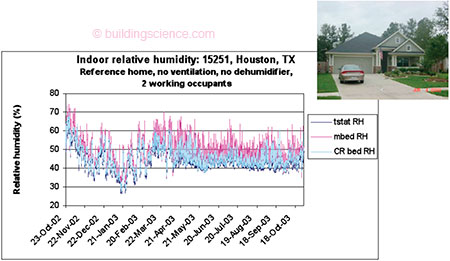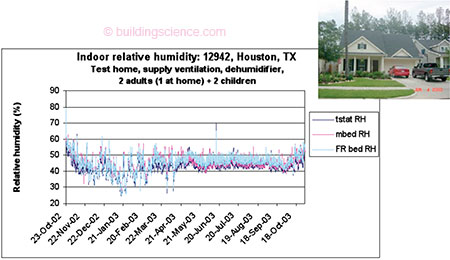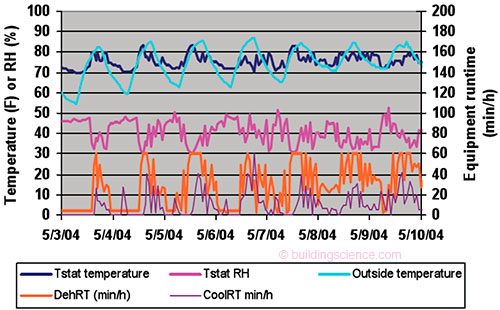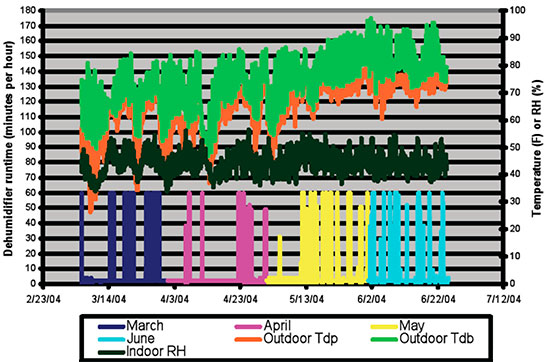This is one of eleven projects from the full report of Building Science Consortium’s research efforts for 2004. The research program is aimed towards advanced building systems that have the potential to reduce residential building energy use by 50-60%. It is based on evaluation of market trends, industry partner needs, and initial results from our team’s system engineering research program. A total of eleven individual research projects were detailed in this report. This project report explores the development of more cost-effective, integrated supplemental dehumidification systems.
Executive Summary
This report details Building Science Consortium's research on advanced building systems under the Building America program during 2004. Eleven research projects are detailed, including: efficient duct systems; rain and groundwater management; humidity control systems; foundation insulation systems; drying rates of building assemblies; climatically-tuned building materials; right-sized air conditioning; solar dehumidification; conditioning systems and control; and advanced framing.
One project (rain and groundwater management) is complete; the others are multi-year projects and will continue into 2005.
Overview
This report details the results of Building Science Consortium’s research efforts for 2004. The research program is aimed towards advanced building systems that have the potential to reduce residential building energy use by 50-60%. It is based on evaluation of market trends, industry partner needs, and initial results from our team’s system engineering research program. Included is a plan for evaluating the technical feasibility and cost-effectiveness for each of these advanced energy systems in the context of whole-building performance.
A total of eleven individual research projects are detailed in this report. Each was developed with one or more of our consortium partner members. Each one of these projects plays an important part in the ability of the production builder to deliver risk-free, durable, energy efficient and healthy homes.
BSC has intentionally balanced the number of projects that directly contribute toward the goal of 40% to 60% increased energy savings (Projects 1, 5, 9, 11, 12) with those that ensure that increased energy savings are part of continued high performance—maintained occupant safety/health/comfort and building durability (Projects 2, 3, 6, 7, 8, 10). BSC has also balanced projects in terms of house systems addressed—mechanical systems (Projects 1, 3, 9, 11), foundations (Project 5), walls (Projects 6, 7, 8, and 12), windows (Projects 2 and 9), and roofs (Project 10).
The eleven projects discussed in this report were developed and deployed with builder and manufacturer teams to move custom and production homes to the next level of energy performance while meeting the commensurate building science demands this level of performance entails.
Project 3 – Supplemental Humidity Control Systems
Team Members Aprilaire, David Weekley Homes, Centex Homes, Del Webb
Description Integrated supplemental dehumidification systems are currently either not available or are only available in top-end, premium systems. In this project, the development of more cost-effective, integrated supplemental dehumidification systems is being explored.
Summary: Cost/Performance Trade-Offs & System Interactions First level supplemental dehumidification systems represents an HVAC system first cost increase of approximately $500 and an increase in annual HVAC operating costs of about $120 to $180, depending on occupant lifestyle, interior moisture generation, and climate. Second level systems that are more energy efficient and have integrated ventilation controls represent an HVAC system first cost increase of approximately $1000 and an increase in annual HVAC operating costs of about $100 to $125. These are balanced against or offset by improvements in moisture control and associated improvements in occupant health, occupant comfort, and building durability.
Final Product(s) A new technical resource will be developed on just where and under what conditions our research indicates that supplemental dehumidification is required, recommended, or not needed.
In cooperation with our Building America team, Aprilaire developed and is producing integrated supplemental dehumidification equipment (Model 1700, www.aprilaire.com) that replaces the first level, ducted, stand-alone, remotely controlled dehumidification units that BSC had been recommending to its production builder clients. While the initial cost is probably still to high to gain mainstream adoption with production homebuilders, except for higher-end homes, there are many new, important advantages to this equipment, and the cost may come down with increased production. See Table 1 for a listing of these advantages over existing competitive equipment. Builder team members will be testing and refining the requirements for this equipment.
Table 1: Value-Added features of the Aprilaire Model 1700 Whole-House Dehumidifier
- $200-$300 lower cost
- Factory insulated cabinet means it will be quieter and won't have condensation problems in humid environments.
- Competitive product shows a maximum operating environment of 100 F. That will preclude its use in most attics.
- The 1700 has a better balance between physical size, water removal capacity. Competitive product is physically much larger, requiring more space for installation, and has higher moisture removal capacity. If more capacity was needed than the 1700 provides (rated 90 pints/day), it would likely be for a large house with multiple air handlers, in which case multiple 1700's on different air handlers would be better than a single larger unit on one air handler.
- Competitive product offers high efficiency filtration at the dehumidifier unit which is not as valuable as providing high efficiency filtration at the air handler. The filter at the dehumidifier may not be as accessible or noticeable for maintenance, and it doesn't process all of the house air. Filtration at the 1700 is a cleanable, re-usable, respectable MERV 8, and high-efficiency filtration can be added at the return air side of the air handler.
- Competitive product is designed to introduce outside air through the dehumidifier. Unless the dehumidifier compressor was made to run whenever outside air was being brought in through the unit, it is better to introduce outside air through the air handler unit, where the mixing ratio between indoor and outdoor air is much greater, reducing the mixed air dew point temperature to avoid possible condensation in cold supply ducts after the central cooling system shuts off. This is especially true if ducts are in conditioned space where they don't warm up very fast after a cooling cycle.
- The 1700 controls include optimized fan and outside air damper cycling capability for efficient whole-house air distribution, providing better dehumidification and ventilation effectiveness. Competitive product allows ventilation periods that are fixed, scheduled periods without taking into account prior equipment operation.
- A remote dehumidistat control is a requirement with competitive product, unnecessarily increasing system cost and installation cost in some cases. Installation of the remote control may be expensive or not possible in some retrofit situations. The 1700 can operate with either the on-board sensor in the intake duct, or by a remote control. The dew point control method of the 1700 system allows the onboard humidity sensor to work properly to dehumidify a remote space even if the unit is located in a hot attic, or cool crawlspace or basement.
Update In 2003, in cooperation with David Weekley Homes, twelve test homes were outfitted and monitored. Eight of the homes were monitored for baseline conditions and four were equipped with experimental dehumidification systems. The data from these homes was collected for a full year, and the monitoring equipment will be removed. In 2004, BSC is working with Aprilaire to install and monitor a new dehumidification system in new homes in Houston, Orlando, and Chicago. Installation in these houses was accomplished in March, April, and August, repsectively, with data downloaded quarterly. The monitoring systems will be removed after a full year of data is acquired.
Of the twelve test homes instrumented with David Weekley Homes (6 in Houston, 3 in Austin, and 3 in Dallas), final data has been retrieved from five of the homes in Houston, and 1 home in Dallas. We still expect to retrieve the monitors from most of the other homes, but some of the monitors will not be retrieved because of the homes having sold or the homeowners dropping their commitment to the study. Data analysis has shown that, if relative humidity is to be controlled to less than 60% year-around, supplement dehumidification is needed. However, depending at least on occupancy and the thermostat cooling setpoint, excursions over 60% were usually not excessive or lengthy, as illustrated in Figure 1. This result is counter to the result found in the previous Houston study with Pulte Homes where air distribution ducts were located inside conditioned space. It seems that, in the discussion of energy efficient homes and supplemental dehumidification, the reduction in heat gain by putting the thermal distribution system inside conditioned space may be a "hinge-point" degining the apparent need for supplemental dehumidification. The eventual required code improvement to R-8 insulated ducts may ave nearly the same effect.
Figure 1: Indoor relative humidity for a Houston reference home without supply ventilation or a supplemental dehumidifier
Figure 2: Indoor relative humidity for a Houston home equipped with ventilation and a low-cost, site-assembled, ducted supplemental dehumidifier
Figure 2 shows the consistent relative humidity control achieveable with supplemental dehumidification, even with mechanical supply ventilation, twice the number of occupants as in the reference home in Figure 1, and an adult at home full time.
The new Aprilaire model 1700 dehumidifier and a full compliment of monitoring equipment was installed in two houses in Houston, constructed by David Weekley Homes, in one house in Orlando constructed by Centex Homes, and in one house in Chicago constructed by Del Webb. The Houston and Chicago houses have controlled mechanical ventilation, the Orlando home does not.
As illustrated in Figure 3, indoor relative humidity was consistently controlled below 50% regardless of mild outdoor conditions and nighttime periods with low sensible cooling load. The chart also shows how dehumidifier operation had a much more direct impact on controlling the indoor realive humidity than operation of the cooling equipment. Another observation from Figure 3 is that, when the dehumidifier is energyized, it often stayed energized for a long time, yielding much and efficient water removal. However, at the conditions shown, the deadband built into the controller logic, between activiation and deactivation, appears to be on the order of 15 to 20 percent relative humidity, which may be greater than optial. The occupants of this test house in the north Houston area stated that they raised the thermostat cooling setpoint by 2 degrees because they felt comfortable at a hight temperature due to the consistently lower relative humidity.
Figure 3: Indoor and outdoor temperature and relative humidity conditions and cooling and dehumidifier equipment runtimes for the north Houston area test house with Aprilaire model 1700 dehumidifier
Figure 4: Outdoor and indoor conditions, and dehumidifier runtimes for south Houston test house with Aprilaire model 1700 dehumidifier
Data shown in Figure 4 is for a test house in the south Houston area where an Aprilaire 1700 dehumidifier was installed. The house was also served by a continuously operating energy recovery ventilator. . .
Download complete report here.




